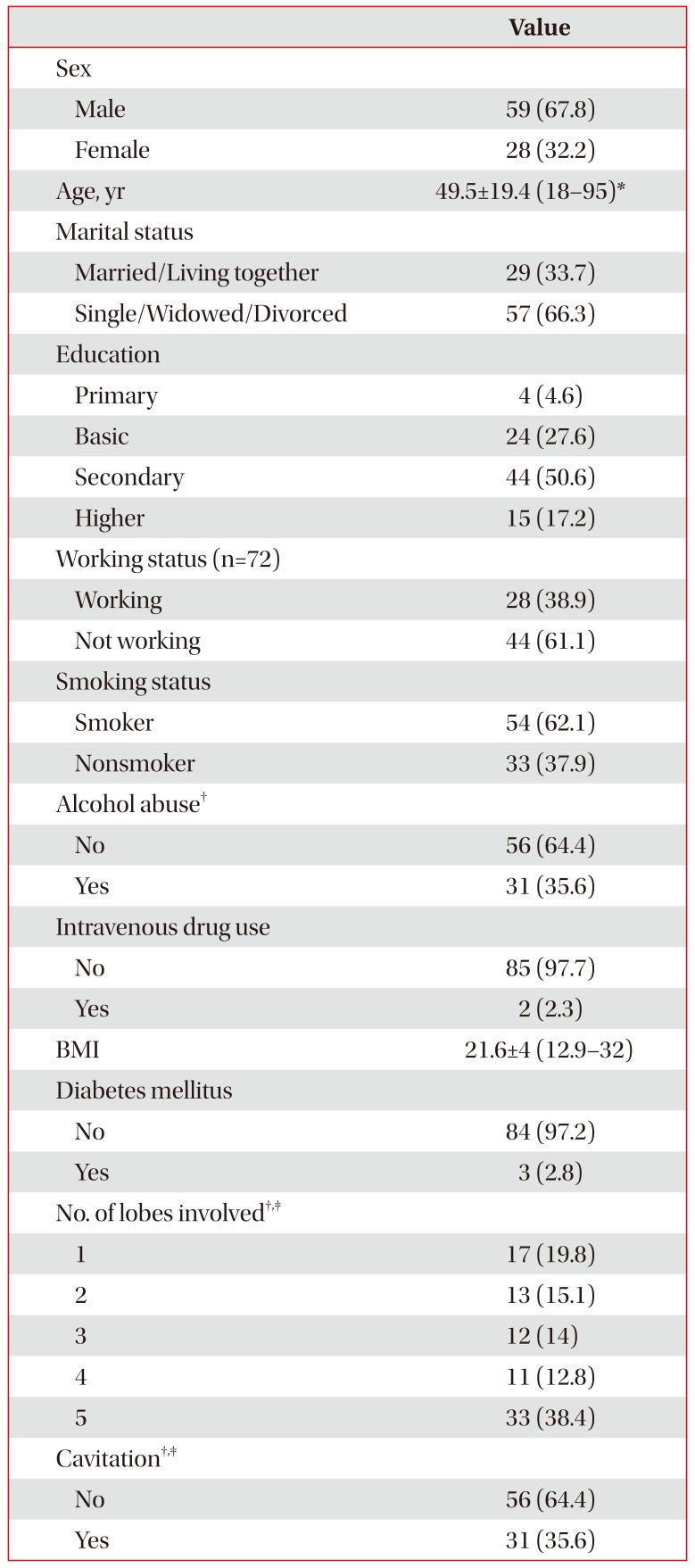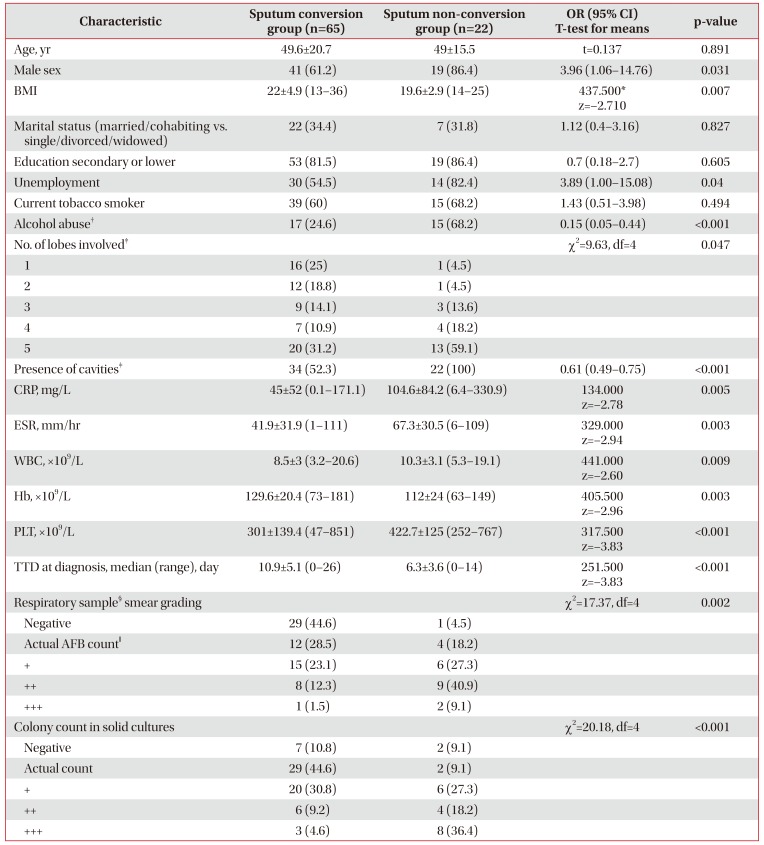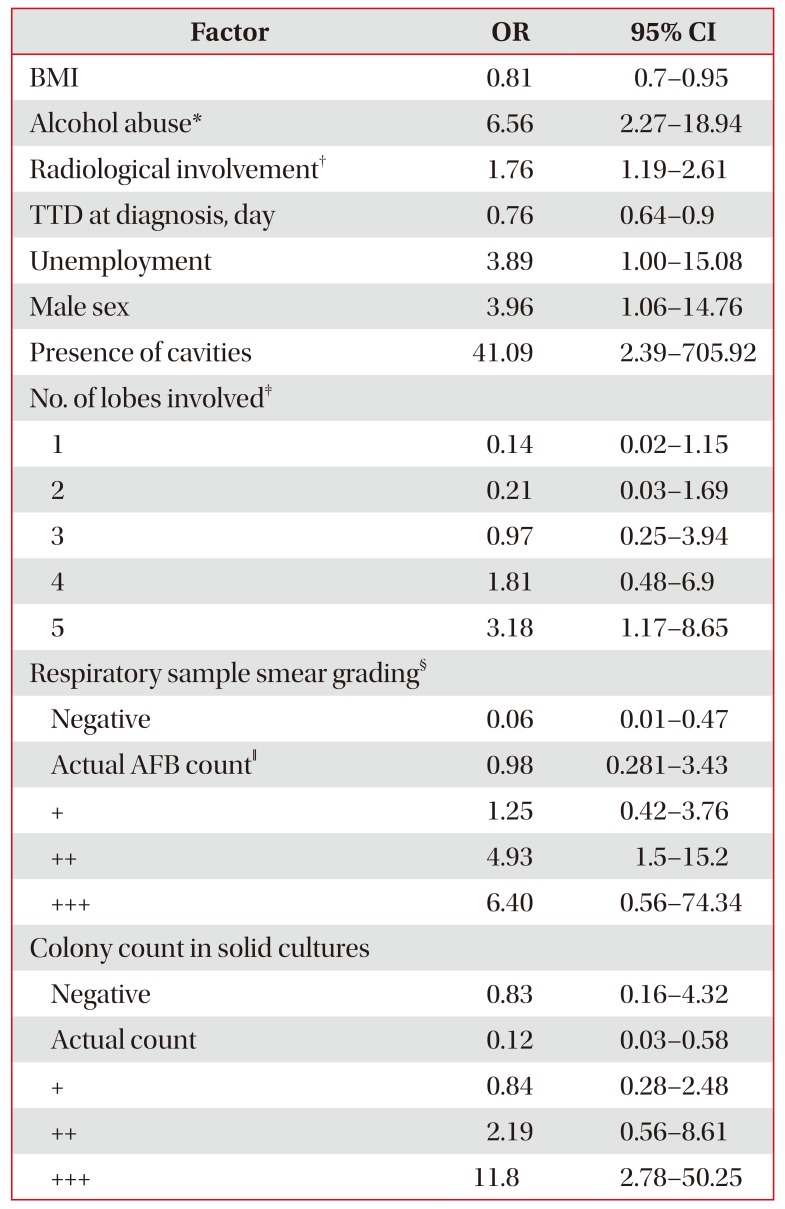2. Epstein MD, Schluger NW, Davidow AL, Bonk S, Rom WN, Hanna B. Time to detection of
Mycobacterium tuberculosis in sputum culture correlates with outcome in patients receiving treatment for pulmonary tuberculosis. Chest. 1998; 113:379–386. PMID:
9498955.
3. Vidal R, Martin-Casabona N, Juan A, Falgueras T, Miravitlles M. Incidence and significance of acid-fast bacilli in sputum smears at the end of antituberculous treatment. Chest. 1996; 109:1562–1565. PMID:
8769512.

4. Dominguez-Castellano A, Muniain MA, Rodriguez-Bano J, Garcia M, Rios MJ, Galvez J, et al. Factors associated with time to sputum smear conversion in active pulmonary tuberculosis. Int J Tuberc Lung Dis. 2003; 7:432–438. PMID:
12757043.
5. Djouma FN, Noubom M, Ateudjieu J, Donfack H. Delay in sputum smear conversion and outcomes of smear-positive tuberculosis patients: a retrospective cohort study in Bafoussam, Cameroon. BMC Infect Dis. 2015; 15:139. PMID:
25884844.

6. Singla R, Osman MM, Khan N, Al-Sharif N, Al-Sayegh MO, Shaikh MA. Factors predicting persistent sputum smear positivity among pulmonary tuberculosis patients 2 months after treatment. Int J Tuberc Lung Dis. 2003; 7:58–64. PMID:
12701836.
7. Visser ME, Stead MC, Walzl G, Warren R, Schomaker M, Grewal HM, et al. Baseline predictors of sputum culture conversion in pulmonary tuberculosis: importance of cavities, smoking, time to detection and W-Beijing genotype. PLoS One. 2012; 7:e29588. PMID:
22238625.

8. Zierski M, Bek E, Long MW, Snider DE Jr. Short-course (6 month) cooperative tuberculosis study in Poland: results 18 months after completion of treatment. Am Rev Respir Dis. 1980; 122:879–889. PMID:
7006476.
9. Guler M, Unsal E, Dursun B, Aydln O, Capan N. Factors influencing sputum smear and culture conversion time among patients with new case pulmonary tuberculosis. Int J Clin Pract. 2007; 61:231–235. PMID:
17166185.
10. Nagu TJ, Spiegelman D, Hertzmark E, Aboud S, Makani J, Matee MI, et al. Anemia at the initiation of tuberculosis therapy is associated with delayed sputum conversion among pulmonary tuberculosis patients in Dar-es-Salaam, Tanzania. PLoS One. 2014; 9:e91229. PMID:
24642636.

11. World Health Organization. WHO global status report on alcohol and health. Geneva: World Health Organization;2014.
12. World Health Organization. Guidelines for treatment of tuberculosis. WHO/HTM/TB/2009.420. Geneva: World Health Organization;2010.
13. European Centre for Disease Prevention and Control. WHO Regional Office for Europe. Tuberculosis surveillance and monitoring in Europe, 2017. Stockholm: European Centre for Disease Prevention and Control;2017.
14. World Health Organization. Definitions and reporting framework for tuberculosis, 2013 revision. WHO/HTM/TB/2013.2. Geneva: World Health Organization;2014.
15. International Union Against Tuberculosis and Lung Disease. International Union Against Tuberculosis and Lung Disease recommended grading of smear microscopy. Paris: International Union Against Tuberculosis and Lung Disease;2000.
16. Hesseling AC, Walzl G, Enarson DA, Carroll NM, Duncan K, Lukey PT, et al. Baseline sputum time to detection predicts month two culture conversion and relapse in non-HIV-infected patients. Int J Tuberc Lung Dis. 2010; 14:560–570. PMID:
20392348.
17. Su WJ, Feng JY, Chiu YC, Huang SF, Lee YC. Role of 2-month sputum smears in predicting culture conversion in pulmonary tuberculosis. Eur Respir J. 2011; 37:376–383. PMID:
20516049.

18. Pheiffer C, Carroll NM, Beyers N, Donald P, Duncan K, Uys P, et al. Time to detection of Mycobacterium tuberculosis in BACTEC systems as a viable alternative to colony counting. Int J Tuberc Lung Dis. 2008; 12:792–798. PMID:
18544206.
19. Pajankar S, Khandekar R, Al Amri MA, Al Lawati MR. Factors influencing sputum smear conversion at one and two months of tuberculosis treatment. Oman Med J. 2008; 23:263–268. PMID:
22334839.
20. Chao WC, Huang YW, Yu MC, Yang WT, Lin CJ, Lee JJ, et al. Outcome correlation of smear-positivity but culture-negativity during standard anti-tuberculosis treatment in Taiwan. BMC Infect Dis. 2015; 15:67. PMID:
25886042.

21. Dorman SE, Johnson JL, Goldberg S, Muzanye G, Padayatchi N, Bozeman L, et al. Substitution of moxifloxacin for isoniazid during intensive phase treatment of pulmonary tuberculosis. Am J Respir Crit Care Med. 2009; 180:273–280. PMID:
19406981.

22. Northcote J, Livingston M. Accuracy of self-reported drinking: observational verification of ‘last occasion’ drink estimates of young adults. Alcohol Alcohol. 2011; 46:709–713. PMID:
21949190.

23. Romeo J, Warnberg J, Nova E, Diaz LE, Gomez-Martinez S, Marcos A. Moderate alcohol consumption and the immune system: a review. Br J Nutr. 2007; 98(Suppl 1):S111–S115. PMID:
17922947.

24. Kliiman K, Altraja A. Predictors and mortality associated with treatment default in pulmonary tuberculosis. Int J Tuberc Lung Dis. 2010; 14:454–463. PMID:
20202304.
25. Jakubowiak WM, Bogorodskaya EM, Borisov SE, Danilova ID, Kourbatova EV. Risk factors associated with default among new pulmonary TB patients and social support in six Russian regions. Int J Tuberc Lung Dis. 2007; 11:46–53. PMID:
17217129.
26. Waitt CJ, Squire SB. A systematic review of risk factors for death in adults during and after tuberculosis treatment. Int J Tuberc Lung Dis. 2011; 15:871–885. PMID:
21496360.
27. Bouti K, Aharmim M, Marc K, Soualhi M, Zahraoui R, Benamor J, et al. Factors influencing sputum conversion among smear-positive pulmonary tuberculosis patients in Morocco. ISRN Pulmonol. 2013; 2013:486507.

28. Wang JY, Lee LN, Yu CJ, Chien YJ, Yang PC. TAMI Group. Factors influencing time to smear conversion in patients with smear-positive pulmonary tuberculosis. Respirology. 2009; 14:1012–1019. PMID:
19659516.

29. National Institute for Health and Care Excellence. Tuberculosis: NICE guideline NG33. London: National Institute for Health and Care Excellence;2016.







 PDF
PDF ePub
ePub Citation
Citation Print
Print



 XML Download
XML Download